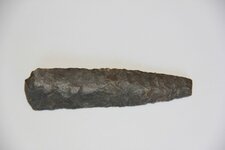redbeardrelics
Hero Member
- Jan 3, 2014
- 891
- 1,024
- Detector(s) used
- Garrett GTI 2500, (Ace 250 spare)
- Primary Interest:
- Other
I have spent a lot of time in the creeks swimming, wading, fishing and turning rocks looking for crawdads or hellgrammites, but have never found a point in the creeks. I feel like I really missed out never thinking to search the gravel bars for artifacts. I was wondering about why points are found in the creeks. Do you think (or know), that it is because the points were lost or rejected while knapping them creekside, or lost while hunting for game in or near the creeks, or do you think most of them are there because the creeks have shifted over time and eroded through the actual campsites, or probably all of the above? Just curious as to how or why the points ended up in the creeks?
Upvote
0


 How wide is the typical flood plain?
How wide is the typical flood plain?




